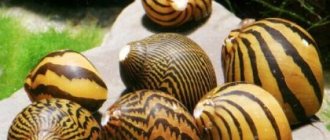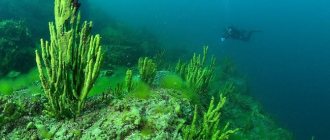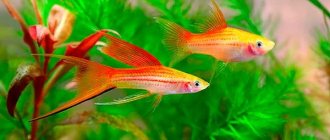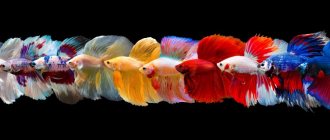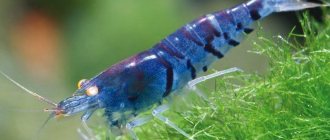Neretina snail photo
Common name: Neritina.
Kingdom: Animals.
Type: Molluscs (Mollusca).
Class: Gastropoda (Gastropoda).
Family: Neritidae.
Species: Neritina.
Range: Sulawesi Island, Indonesia, Southeast Asia, South Africa, Kenya, Somalia, Tanzania.
Sexual dimorphism: dioecious, without any special differences.
Maximum size: no more than 2.5 cm.
Life expectancy: 2 – 3 years.
Water parameters for neretina: pH 6.5 – 8.0, dH 6 – 20. Acidic conditions can stimulate shell erosion and should be avoided. It is best to maintain a harsh alkaline environment. Temperature: 22 - 26 0C. Minimum aquarium volume: 8 - 10 liters per individual.
Hello to all visitors to the site FanFishka.ru. In this article I want to introduce you to the mollusk - Neritina, Ner and Tina, also known as Neretina. This is a very popular freshwater snail with an amazing and unique pattern on its shell, the shape of which resembles a drop of water in flight. Peaceful, nocturnal and very fond of algae, the mollusk will become an indispensable assistant in every herbalist.
I immediately recommend a couple of our videos about neretina and algae for mandatory viewing. Extremely educational visualization.
Description of Neretina snails
Neretina snail in an aquarium photo
The operculum (lid or “hatch” that completely or partially covers the hole in the shell) of these mollusks is small in size and located on one of the sides. The head and leg are oval-shaped, and the mouth is round. The antennae are thread-like. The eyes of the mollusk are located on small irregularities. The body most often has a gray color, and the head and mantle are black or brownish-gray dotted. The size of neretinas depends on the species and does not exceed 3.5 cm.
The shells of these mollusks are colored very differently and no two snails have the same shell pattern. Black, dark brown, dark green, olive, and red-orange individuals are described. Snail shells are decorated with a pattern of stripes, spots, dots, strokes, and the shell itself may have outgrowths or horns.
Neritines are not hermaphrodites, but it is not possible to distinguish their gender, since there are simply no external signs.
Getting offspring
It is quite difficult to breed offspring from this species. Neretines are not hermaphrodites, they are heterosexual snails . This will only play into the hands of the aquarium owner, since there will be no problem with overpopulation of the aquarium. For full reproduction and survival of offspring, warm brackish water is necessary; neretinas rarely breed in fresh water. Eggs are laid on plant foliage or in the ground . The caviar is white and easily visible. For reproduction, it is necessary to keep about 10 snails together , since it is impossible to determine their gender externally. The eggs die in fresh water .
Care and maintenance of Neretina snails
Neretina snail in an aquarium photo
The larger the aquarium, the calmer these mollusks will feel. For painless maintenance, it is necessary to avoid sudden changes in water, increased acidity and poor filtration. Therefore, you will have to get a good filter and carry out mandatory weekly changes of 30% of the water in the aquarium. It is worth mentioning that Neretina snails are prone to escape, so having a lid will not be amiss. However, it is worth considering that you should be very careful when introducing Neretina snails into the aquarium, lowering the snail to the bottom of the aquarium and under no circumstances throwing it. These snails cannot roll over and may die. They are also afraid of drugs containing copper.
Any peace-loving fish will be suitable as neighbors. You definitely shouldn’t add them to cichlids, loaches and helen snails.
Neretinas usually live in aquariums for about two years. However, they often die immediately after being placed in the aquarium. The reason is simple – inappropriate water temperature during transportation. Dead neretina snails quickly decompose, spoil the water and smell unpleasant in the aquarium.
Features of an aquarium tank
Despite the unpretentiousness of these mollusks, they still need certain conditions; do not forget that we are talking about tropical inhabitants:
- they love warm water - the temperature of which should be 24°-27°C, and for some varieties - 29°-30°C;
- pH value – about 7.5;
- hardness – high or medium; soft water is not suitable for snails. When the water environment is soft, increasing the hardness is necessary - this is important for the full formation of the shell;
- neretins are sensitive to ammonia and nitrates in water - the level of these elements should be regularly measured;
- change the water weekly - by 20-30%, it must be pre-settled and not contain chlorine.
Experts warn that if you treat fish with drugs containing copper, this can provoke the death of mollusks, this also applies to neretins. It is important to introduce new inhabitants into the tank correctly - carefully so that they do not fall or turn over upside down. Not all individuals manage to roll over on their own, and some die in such a desperate situation.
It is necessary to release snails into a decorated tank with a balanced environment and abundant landscaping. If all parameters are stable, then the mollusks quickly adapt to new conditions. Vegetation will become the first food of neretinas - they will eat up decaying areas. The basis of the diet of these mollusks is algae, so they must be present in the tank.
Neretina are quite easy-going and can live well with any non-aggressive fish and invertebrates. They themselves do not cause harm to other inhabitants, but they can become dinner for large fish or inhabitants whose menu includes snails, for example, tetradons.
Reproduction and breeding of Neretina snails
Neretina snail
If you decide to breed Neretina snails, you need to start a separate aquarium with brackish water. The female's clutch is usually placed on a rocky area of stones or interior elements. The eggs are white and no more than 3 mm in size, very similar to sesame seeds. After fertilization, it is necessary to transfer the element with the clutch to a spawning aquarium within no more than three days and gradually add salt to the water. Small Neretina snails do not crawl, but swim.
Compatibility
Neretina snails never show any hostility towards other inhabitants of an artificial reservoir. But they themselves can become easy prey for predatory and omnivorous fish and shrimp. They also do not get along well with other types of mollusks and crayfish.
They will wage war with Ampularia, Achatina, Phys, and Coils for the territory of eating algae. And they get along well with bivalves or Melania.
It is strictly forbidden to put them into the same body of water with cichlids, macropods, tetradons, golden cockerels, and large catfish species.
Natalensis snail Neretina zebra
(Neritina natalensis), Reeve, LA, 1845
Synonyms: Neretina zebra, Zebra Nerita, Tiger Nerite, red-spotted, ring-striped.
Distribution: Eastern, Northern and Southern Africa: coastal Mozambique, Kenya, Somalia, Tanzania.
Size: from 2 to 3 cm.
Life expectancy: 2 to 3 years.
Shell color and shape: beautiful golden color with black stripes.
Features: good at cleaning the walls of the aquarium, snags, plants from algae, prone to escape.
Tiger snail Neretina
(Neritina turrita), Gmelin, 1791
Distribution: Southeast Asia, Pacific Islands.
Size: no more than 2.5 cm (sizes up to 3.5 cm are available).
Life expectancy: 2 to 3 years.
Color and shape of the shell: the shell is round in shape and yellow in color with vertical stripes ranging from light brown to dark.
Features: good at cleaning the walls of the aquarium, snags, plants from algae, prone to escape.
What to look for when buying neritin
- You need to carefully inspect the sink for cracks and other damage.
- If possible, observe the behavior of snails. It is better not to take specimens lying on the bottom.
- Be sure to look inside the sink. No matter how funny it may sound, there are known cases of buying empty sinks.
Let's summarize. The Neretina snail for an aquarium is wonderful for everyone: it is beautiful, it is an unsurpassed cleaner, it does not harm plants and other inhabitants of the aquarium, it is not difficult to acquire, it is easy to care for, and it will not burden you with unwanted offspring. The only drawback is that the egg laying spoils the appearance, but this is quite easy to fix.
PHYSAL SNAIL CONTENTS COMPATIBILITY REPRODUCTION DESCRIPTION PHOTO VIDEO.
AQUARIUM SNAIL COIL CONTENTS REPRODUCTION COMPATIBILITY DESCRIPTION PHOTO.
AMPULAR CONTENTS REPRODUCTION COMPATIBILITY PHOTO DESCRIPTION.
Olive snail Neretina
(Olive Nerite Snail)
Olive snail Neretina
Settlement: Japan, Thailand, China, Indonesia and the Philippines.
Size: from 1 to 2 cm.
Life expectancy: from 3 to 5 years.
Shell color and shape: deep olive color with dark stripes.
Features: prone to escape in case of poor conditions.
Neretina horned snail
(Horned Nerite Snail)
Neretina horned snail
Settlement: South Africa.
Size: up to 1.5 cm.
Life expectancy: from 3 to 5 years.
Shell color and shape: There are growths on the shell, located in a chaotic manner. The growths can break off, which does not in any way affect the health of the snail.
Features: not prone to escape. Snails have different horns. Often the processes are located at the top of the shell.
Nutrition
Neritins eat any algae very well, more effectively than ampullaria. This makes them excellent aquarium cleaners. These mollusks constantly move around the aquarium, cleaning it of various algae. But neretina do not cause harm to aquarium plants; they can only feed on rotten parts. But Neretina snails cannot rid your aquarium of all algae, since their appearance indicates an imbalance in the aquarium. To solve this problem, you need to eliminate its cause.
Shellfish should be fed with spirulina, cereal flakes, and pieces of vegetables.
When consuming food, neretina moves around the aquarium and then freezes for a long time. If you notice this behavior in your pet, then don’t worry. Take the snail out and smell it; a dead clam emits an unpleasant odor.
Neretina red-spot snail
(Red Spotted Nerite)
Synonyms: ring-striped.
Settlement: South Africa.
Size: up to 2.5 cm.
Life expectancy: up to 3 years.
Shell color and shape: red with black spots of different sizes arranged in a spiral.
Features: Neretinas of this species love warmer water, around 30 0C. They are sensitive to acidity, which should not exceed pH=7, otherwise the shell will collapse and the mollusk will die. Prone to escape.
Varieties
There are several species of freshwater neretina, four of which are represented in our aquariums. The types differ in the shape and color of the shell. All types of neretina have the same behavior, character and conditions of detention.
- Neretina zebra is the most common species. A low shell of greenish-yellow or grayish-orange-yellow colors with uneven black stripes directed down and forward, like rays radiating from the top of the shell.
- Neretina red-spotted - the shell of this snail is orange or orange-red in color, with a mahogany tint. Along its surface there are rows of small and large dots and strokes, forming a beautiful ornament.
- Neretina Hedgehog - a beige-yellowish shell is covered with raised “ribs” with darker protrusions on them, really reminiscent of hedgehog spines.
- Neretina Black Ear is a very dark, almost black shell that looks quite interesting. The shape, slightly more flattened than that of other nerets, is similar to an ear.
Neretina sun snail
(Clithon corona), Linnaeus, 1758
Synonyms: beeline.
Settlement: China, Philippines, Indonesia, Malaysia, Thailand.
Size: up to 2 cm.
Life expectancy: up to 3 years.
Shell color and shape: greenish in color and ribbed in shape, with growths resembling horns.
Features: One of the best types of snails to control algae in an aquarium, which carefully eat algae without harming the plants. Prone to escape.
Feeding
Neretina actively consume all existing aquarium algae. Constantly moving over various surfaces, they leave behind an absolutely clean space.
Snails are absolutely not interested in aquarium plants. They do not cause them the slightest harm.
Algae alone is not enough to create a complete diet. Snails also need mineral supplements with calcium, for example, the most accessible is crushed eggshells . They are also fed finely chopped vegetables and fish food in powder form.
When kept together with fish, nerets can feast on their eggs.
Neretina snail diseases
Neretina snail photo
All diseases of Neretina snails, like fish, occur from improper care and poor water quality, monotonous feeding. Therefore, it is necessary to maintain the water parameters in the aquarium necessary for the healthy life of the mollusk: temperature, hardness and acidity. Cracks and chips in the shell can heal only if the snail is given complete rest conditions and a large amount of calcium-containing food is included in the diet.
A white coating on the shell indicates the aging of the snail. A plaque similar to mold can be caused by fungal infections; in this case, it is necessary to place the snail in a separate tank and take baths with salt or potassium permanganate.
For prevention purposes, it is necessary to place new neretine snails in a separate quarantine and monitor their health.
And the author of the article is Argenty (Alexander Isakov)
Recommended Video
Subscribe to our YouTube channel so you don't miss anything
How do mollusks reproduce?
In order for Neretina eggs to successfully survive the incubation period, they must be in salt water, since these gastropods do not breed in fresh water environments. Snail eggs, resembling whitish dots, can be seen on various surfaces of the tank, especially black ones.
Clam caviar has a hard shell and is difficult to scrape off, and since they spawn frequently and in large quantities, it can spoil the appearance of the underwater world. Caviar will appear, but in order for it to mature to the desired condition, certain conditions close to natural are required. As a rule, amateurs do not succeed in producing Neretina offspring, but experienced breeders can do this.
Neretina snails are unique creatures that work for the benefit of their home and at the same time are a decoration and an interesting object for observation. It is not surprising that interest in them is only increasing.






